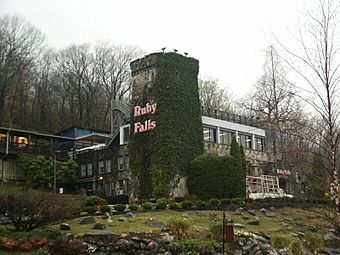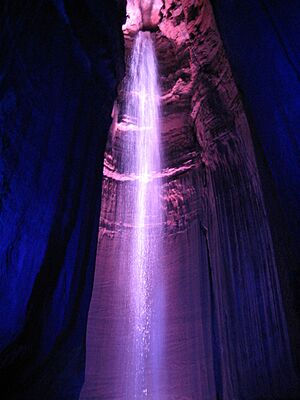Ruby Falls facts for kids
Quick facts for kids |
|
|
Lookout Mountain Caverns and Cavern Castle
|
|

Ruby Falls' Visitors Center (Cavern Castle)
|
|
| Location | Scenic Hwy., Chattanooga, Tennessee |
|---|---|
| Area | 10 acres (4.0 ha) |
| Built | 1929 |
| Architect | Lambert, Leo B.; Brown Contracting Co. |
| NRHP reference No. | 85002969 |
| Added to NRHP | November 26, 1985 |
Ruby Falls is an amazing underground waterfall found inside Lookout Mountain. It's located near Chattanooga, Tennessee, in the United States. This beautiful waterfall drops 145 feet (about 44 meters) into a pool deep inside the mountain. It's a popular spot for tourists to explore!
How Ruby Falls Formed
Ancient Seas and Rock Formation
Millions of years ago, about 200 to 240 million years ago, the area where Tennessee is now was covered by a shallow sea. Over time, mud and sand settled at the bottom of this sea. These layers eventually hardened into a type of rock called limestone.
Mountain Building and Cave Creation
Around 200 million years ago, the land began to push up. This process created Lookout Mountain and other nearby hills. Rainwater, which is slightly acidic, started to seep into tiny cracks in the limestone. Slowly, this water dissolved the rock, making the small cracks wider and wider. This is how the many caves inside Lookout Mountain were formed.
Two Caves, One Mountain
Among these caves were Lookout Mountain Cave, which had an opening to the outside, and Ruby Falls Cave, which was completely hidden. For a long time, no one knew Ruby Falls Cave existed. The two caves were not connected until people dug tunnels to join them. Ruby Falls Cave is higher up in the mountain and has many cool rock formations that the other cave doesn't have.
Amazing Cave Formations
Ruby Falls Cave is full of incredible rock shapes. You can see stalactites, which hang down from the ceiling like icicles. There are also stalagmites, which grow up from the cave floor. When stalactites and stalagmites meet, they form tall columns. You might also see "drapery" that looks like curtains, and "flowstone," which looks like frozen waterfalls on the cave walls.
The Waterfall's Source
The Ruby Falls waterfall is at the very end of the main cave passage. It falls into a large, deep shaft. The water for the falls comes from both rainwater and natural springs. It collects in a pool on the cave floor. Then, it continues to flow through the mountain until it finally joins the Tennessee River at the base of Lookout Mountain.
The Story of Its Discovery
A Hidden Gem
Unlike Lookout Mountain Cave, Ruby Falls Cave had no natural entrance. No one could get inside until the 1900s. This means there are no old tools or artifacts inside, which are sometimes found in other caves. In 1905, the natural entrance to Lookout Mountain Cave was closed because a railway tunnel was being built.
Leo Lambert's Big Idea
In the 1920s, a chemist named Leo Lambert loved caves. He thought he could reopen Lookout Mountain Cave as a tourist attraction. He started a company to do this. His plan was to dig a new opening higher up the mountain and use an elevator to take visitors down to the cave.
An Amazing Accident
In 1928, Lambert's team began drilling through the limestone. They accidentally found a small opening, only about 18 inches high and four feet wide. When Lambert explored this tiny passage, he discovered the hidden Ruby Falls Cave and its beautiful waterfall! On his next trip, he brought his wife, Ruby, and told her he would name the falls after her.
Opening to the Public
After finding Ruby Falls Cave, the workers kept digging. They eventually reached the original Lookout Mountain Cave, which was 1,120 feet underground. On December 30, 1929, Lookout Mountain Cave opened to the public. By June of the next year, Ruby Falls Cave was also ready for visitors. Ruby Falls became much more popular, so by 1935, the lower Lookout Mountain Cave was closed off.
Changes for Visitors
In 1954, a pathway was built around the pool at the bottom of the falls. This gave tourists a much better view. There's a funny saying about not drinking the water from the falls. Even though it's pure and safe, it has a lot of magnesium. This makes it a natural laxative!
In 1975, a second exit was added from the falls to the base of the mountain. This was done to follow safety rules in Tennessee. This exit is used if the main elevator ever stops working. This second exit was also used for a popular haunted attraction called Ruby Falls Haunted Cavern until 2017.
Visiting Ruby Falls
Leo Lambert decided to open both caves for people to visit. However, Lookout Mountain Cave closed in 1935 because tourists liked the upper Ruby Falls Cave much more. Public tours of Ruby Falls started in 1930. Electric lights were put in the cave, making it one of the first commercial caves to have them.
If you traveled on I-75 in the 1970s and 1980s, you would have seen many billboards saying "SEE RUBY FALLS" for hundreds of miles! Ruby Falls is still a very important part of Chattanooga tourism. It is open every day.
Ruby Falls and the larger Lookout Mountain Caverns complex are recognized as a National Historic Landmark. It is often visited along with the nearby Rock City attraction, which is on top of Lookout Mountain.
Images for kids





